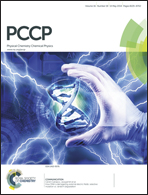Proton transfer reactions of 4′-chloro substituted 3-hydroxyflavone in solvents and aqueous micelle solutions
Abstract
Flavonol 4′-chloro,3-hydroxyflavone (Cl-3HF) has been investigated in solvents of varying polarity and hydrogen-bonding capacity as well as in aqueous micelle solutions. Quantum chemical calculations indicate that although the Cl-atom at the 4′-position of the 2-phenyl ring weakly perturbs the electron distribution of the parent 3-hydroxyflavone, the nuclear framework remains largely intact, and excited state intra-molecular proton-transfer (ESIPT) is feasible. The ESIPT process in both polar solvents and micelles was found to be fast and irreversible, with remarkably long time-constants of several tens of picoseconds. This dramatic inhibition of the ESIPT rate (which is intrinsically a sub-picosecond event) could be rationalized in terms of the emergence of complexes between the solvent and the enol form of Cl-3HF, whose dynamics is coupled to the relatively slow dynamics of inter-molecular hydrogen bonds. In the micelle solutions, spectroscopic data establish that the guest Cl-3HF molecules localized almost exclusively at the polar exterior shell, where they experienced a nearly uniform local environment similar to that in moderately polar solvents. Thus, the Cl-3HF molecules tend to avoid the non-polar core of the micelles, in spite of being strongly hydrophobic themselves. This apparently unusual observation is explained by the formation of inter-molecularly hydrogen-bonded complexes between the guest Cl-3HF and the water molecules tethered to the polar shells of the micelles.


 Please wait while we load your content...
Please wait while we load your content...